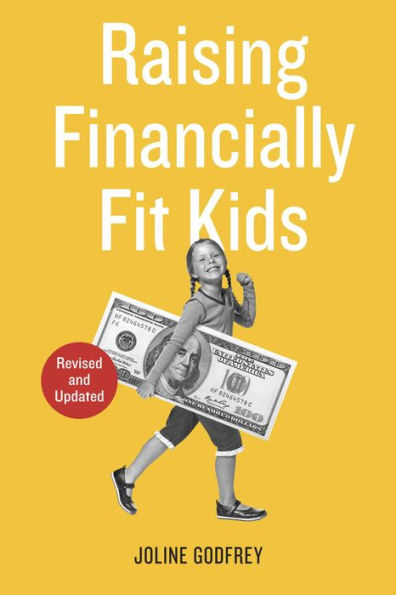Raising Financially Fit Kids, Revised
This combination parenting and personal finance book helps parents teach their children key money skills--such as saving, spending, budgeting, investing, building credit, and donating--that they'll need to become financially secure adults.
In this updated edition of Raising Financially Fit Kids, Joline Godfrey shares knowledge gleaned from two decades of preparing children and families for financial independence and stewardship, philanthropic effectiveness, and meaningful economic lives. At the heart of the book are three big ideas:
• Financial education is not just about the money; it’s
about building great families and raising self-confident kids who have the tools to realize their dreams.
• Financial sustainability means living within one’s means and acquiring skills to create and manage human and financial capital.
• Giving wisely is a global citizen’s responsibility.
Designed for parents, grandparents, mentors, advisors, and educators, Raising Financially Fit Kids uses ten core money skills applied across five developmental life stages: children, tweens, middle schoolers, high schoolers, and twenty-somethings. Each stage includes age-appropriate activities that make financial fitness fun, from mall scavenger hunts to financial film festivals.
In this global economic landscape, we all need financial fluency. Whether your child is five, fifteen, or twenty-five years old, it’s never too late to teach financial literacy. Raising Financially Fit Kids prepares your children for the complexities of living in a global economy and helps your family up your game from good to great.
1112807363
In this updated edition of Raising Financially Fit Kids, Joline Godfrey shares knowledge gleaned from two decades of preparing children and families for financial independence and stewardship, philanthropic effectiveness, and meaningful economic lives. At the heart of the book are three big ideas:
• Financial education is not just about the money; it’s
about building great families and raising self-confident kids who have the tools to realize their dreams.
• Financial sustainability means living within one’s means and acquiring skills to create and manage human and financial capital.
• Giving wisely is a global citizen’s responsibility.
Designed for parents, grandparents, mentors, advisors, and educators, Raising Financially Fit Kids uses ten core money skills applied across five developmental life stages: children, tweens, middle schoolers, high schoolers, and twenty-somethings. Each stage includes age-appropriate activities that make financial fitness fun, from mall scavenger hunts to financial film festivals.
In this global economic landscape, we all need financial fluency. Whether your child is five, fifteen, or twenty-five years old, it’s never too late to teach financial literacy. Raising Financially Fit Kids prepares your children for the complexities of living in a global economy and helps your family up your game from good to great.
Raising Financially Fit Kids, Revised
This combination parenting and personal finance book helps parents teach their children key money skills--such as saving, spending, budgeting, investing, building credit, and donating--that they'll need to become financially secure adults.
In this updated edition of Raising Financially Fit Kids, Joline Godfrey shares knowledge gleaned from two decades of preparing children and families for financial independence and stewardship, philanthropic effectiveness, and meaningful economic lives. At the heart of the book are three big ideas:
• Financial education is not just about the money; it’s
about building great families and raising self-confident kids who have the tools to realize their dreams.
• Financial sustainability means living within one’s means and acquiring skills to create and manage human and financial capital.
• Giving wisely is a global citizen’s responsibility.
Designed for parents, grandparents, mentors, advisors, and educators, Raising Financially Fit Kids uses ten core money skills applied across five developmental life stages: children, tweens, middle schoolers, high schoolers, and twenty-somethings. Each stage includes age-appropriate activities that make financial fitness fun, from mall scavenger hunts to financial film festivals.
In this global economic landscape, we all need financial fluency. Whether your child is five, fifteen, or twenty-five years old, it’s never too late to teach financial literacy. Raising Financially Fit Kids prepares your children for the complexities of living in a global economy and helps your family up your game from good to great.
In this updated edition of Raising Financially Fit Kids, Joline Godfrey shares knowledge gleaned from two decades of preparing children and families for financial independence and stewardship, philanthropic effectiveness, and meaningful economic lives. At the heart of the book are three big ideas:
• Financial education is not just about the money; it’s
about building great families and raising self-confident kids who have the tools to realize their dreams.
• Financial sustainability means living within one’s means and acquiring skills to create and manage human and financial capital.
• Giving wisely is a global citizen’s responsibility.
Designed for parents, grandparents, mentors, advisors, and educators, Raising Financially Fit Kids uses ten core money skills applied across five developmental life stages: children, tweens, middle schoolers, high schoolers, and twenty-somethings. Each stage includes age-appropriate activities that make financial fitness fun, from mall scavenger hunts to financial film festivals.
In this global economic landscape, we all need financial fluency. Whether your child is five, fifteen, or twenty-five years old, it’s never too late to teach financial literacy. Raising Financially Fit Kids prepares your children for the complexities of living in a global economy and helps your family up your game from good to great.
8.99
In Stock
5
1

Raising Financially Fit Kids, Revised
224
Raising Financially Fit Kids, Revised
224
8.99
In Stock

Product Details
| ISBN-13: | 9781607744092 |
|---|---|
| Publisher: | Clarkson Potter/Ten Speed |
| Publication date: | 06/04/2013 |
| Sold by: | Random House |
| Format: | eBook |
| Pages: | 224 |
| File size: | 14 MB |
| Note: | This product may take a few minutes to download. |
About the Author
From the B&N Reads Blog
